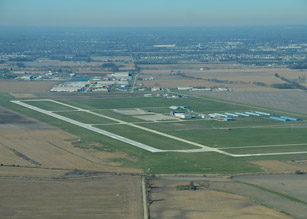
It’s warm today in the heartland. The short, chilly days of winter flying are over as you launch a spring project to complete the cross-country requirements for your private pilot certificate.
Not yet noon, already airports in the Indianapolis area are heating up as evidenced by METARs from numerous local fields. Typical, today, is your planned destination, Indianapolis Regional Airport—site of the AOPA Regional Fly-In on May 31—where on a recent morning the 1725Z automated observation offered this information: 22013G18KT 10SM CLR 29/16 A2999.
You can visualize how an arrival might progress at the nontowered airport east of Indianapolis today. The two-runway airport’s L-shaped configuration should help you spot the field in the flat countryside from the air. The reported winds would seem to favor the 5,504-foot-long Runway 25.
Monitor the common traffic advisory frequency, then give the automated weather another check as you near the airport. The recording provides another important piece of hot-weather information: the density altitude. At 862 feet msl, the airport does not sit at an unusually high elevation. But with a reported surface temperature of 29 degrees Celsius (84 degrees Fahrenheit), density altitude has increased to 2,700 feet. That’s a tip to expect a takeoff run that consumes somewhat more runway than if conditions were standard. Climb performance will be less robust too; check your pilot’s operating handbook’s performance data for specifics. (This exercise is an opportunity to practice interpolating POH data, as might be required for cross-country planning on your checkride.)
Hot weather reminds you to keep a close eye on engine temperature. Don’t hurry your ground prep or rush your departure, but remember that a closely-cowled air-cooled powerplant heats up quickly. After takeoff, climb smartly to a safe altitude—always good piloting technique. During the next phase of your departure climb, use an airspeed—that is, a pitch attitude—that provides adequate cooling. (Check out the Air Safety Institute’s Engine and Propeller online course.)
Inbound and outbound from Indianapolis Regional, monitor weather developments on the Hazardous In-flight Weather Advisory Service (HIWAS) available over the Shelbyville VOR, 13 nautical miles southeast of the airport.
And because a pilot has much to think about on a cross-country flight, Lockheed Martin Flight Services offers a reminder service to help you remember to close the VFR flight plans for your outbound and return flights.



